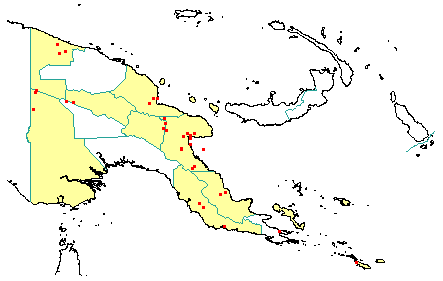
in PNGplants database
PNGTreesKey – Vernonia arborea Buch.-Ham. |
Barry Conn (NSW) & Kipiro Damas (LAE).
Guide to trees of Papua New Guinea
Copyright held by the authors, National Herbarium of New South Wales, and Papua New Guinea National Herbarium
Transactions of the Linnean Society. Botany Vol. 14: 218 (1824)
Family: Asteraceae
Dicotyledon
Timber Group: Non-timber species
Field Characters: Small sub-canopy tree (up to 25 m high); Bole cylindrical (up to c. 25 cm diam.); straight (bole up to c. 12 m long); buttresses buttresses absent; spines spines absent; aerial roots aerial roots absent; stilt roots stilt roots absent; Bark pale brown, rough, furrowed cork or pustular (slightly to prominently ridged), lenticels irregular; Subrhytidome (under-bark) yellowish brown, yellow, or green; less than 25 mm thick, 5.0-9.0; bark blaze consisting of one layer; strongly aromatic; unpleasant; outer blaze yellow, markings absent or speckled, granular with splinters or slightly fibrous; inner blaze yellow, markings absent or speckled, slightly fibrous or granular with splinters; bark exudate (sap) present, colourless, not readily flowing (spotty), colour changing on exposure to air, to greenish black or dark brown, not sticky; terminal buds not enclosed by leaves.
Indumentum: Complex hairs absent; stinging hairs absent; mature twig indumentum (hairs) present (indumentum silky), hairs dense.
Leaves: Leaves spaced along branches, spiral (leaves occurring singly at a node and arranged spirally up the branchlet), simple (a leaf composed of a single blade); petiole present, not winged, attached to base of leaf blade, not swollen; leaves broadest below middle, 4.0-16.5 cm, 2.5-6.0 cm; symmetric (to slightly asymmetric), entire, not dissected or lobed, acute, venation pinnate, secondary veins open, prominent, intramarginal veins absent; leaves lower surface whitish green, upper surface green (rough to touch), indumentum (hairs) present, indumentum (hairs) dense or sparse (hairy on both surfaces, but denser on lower surface); absent; domatia absent; stipules absent.
Flowers: Inflorescence terminal, flowers on a branched axis (flower heads arranged in a panicle) or flowers arising from a single point (head), cones absent; flowers bisexual, not stalked, flowers with many planes of symmetry, 4.0-5.0 mm long, diameter small (up to10 mm diam.) (3-4 mm diam.); perianth present, with distinct sepals and petals whorls, inner perianth white or purple (pale to lavender on lobes); 5, some or partly joined; stamens 100, present, joined, free of the perianth; ovary inferior, carpels joined (when more than one), locules 1; styles solitary, 1.
Fruits: Infrutescence arising from single point (head) or arranged on branched axis (fruiting heads arraned in a panicle), fruit 3.0-5.0 mm long, 1.0-2.0 mm diam., dark brown, not spiny, non-fleshy, simple, indehiscent, achene (cypsela); seeds 1, barely visible (to 1 mm long), not winged (but single-seeded fruit with white pappus), narrow (longer than wide), seed less than 1 mm diam.
Distribution: West Sepik, Madang, Morobe, Western Highlands, Eastern Highlands, Western, Central, Northern & Papuan Islands.
 | Botanical records in PNGplants database |